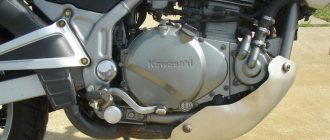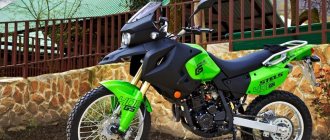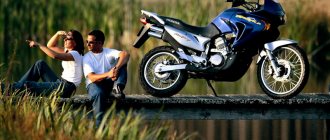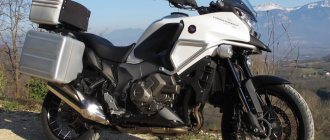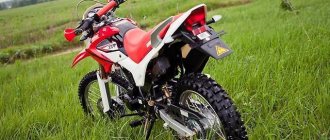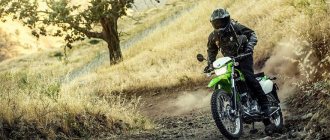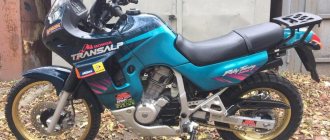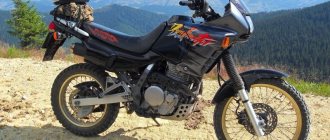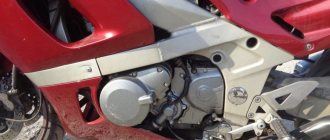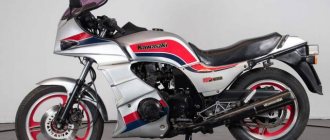Year of release
The Kawasaki KLE 250 touring enduro model was produced without any changes throughout the entire production period.
It was published in 1993 , but did not have the expected success. Sales in the Japanese market are weak . Exporting the model to European countries does not help the situation. The developers are talking about closing production and stopping it several times. Finally, in 2001 , the model finally went down in history.
Although the model belongs to the enduro tour, users note that from this proud name there is only a large suspension travel (117 - front, /200 - rear), high ground clearance and engine protection.
If not for these details, the motorcycle could be classified as a road bike.
Specifications
The engine is based on a unit from a Kawasaki ZZR250 tourist. It has been retuned; by cutting down the power, thrust has been added at low revs and leveled out at mid-rpm.
Two-cylinder engine.
Liquid cooling.
Mechanical clutch.
Exhaust pipes.
As a result we got:
- working volume - 248 cm3;
- number of cylinders - 2;
- number of cycles - 4;
- number of valves - 8 (4 per cylinder);
- power - 35 hp;
- torque - 23.5 Nm;
- cooling - liquid;
- fuel supply - carburetor, Keihin, 2x;
- ignition - transistor (TDI);
- start - electric starter;
- tank volume - 12 l.
Some comments note an unhealthy craving for AI-95 .
Transmission and clutch
The main gear is a classic chain drive.
As is customary with Kawasaki enduros, the motorcycle had a 6-speed manual transmission .
The gears were switched on clearly, the desired one was located without problems.
Users noted an interesting feature - “ the box doesn’t make any characteristic clicks when turned on, it works completely silently , so sometimes it’s unclear what gear you’re in.”
At the same time, its elasticity is noted - the third speed is enough for starting off and for traveling at 100 km/h.
- The clutch is multi-disc , based on the wet sump principle. Power transmission is a cable .
- The main drive is chain .
Brakes
Since the bike was in many respects the same as one of its older brothers (KLE 400), it received the same brakes. Hydraulics, one disc per axle.
Front brakes.
Rear brakes.
Front:
- number of disks - 1;
- diameter - 300 mm;
- support - 2-piston.
Rear:
- number of disks - 1;
- diameter - 230 mm;
- support - 1-piston.
Since the model was positioned as a budget model, no additional options were offered .
Dimensions and weight
In terms of dimensions, this is an impressive machine, although relative to other enduros the weight and dimensions are average. These correspond to the technical characteristics of the motorcycle, allowing you to realize the full potential of the engine, chassis and transmission without harm to the bike and the rider.
The dimensions are as follows:
- height – 1165 mm;
- width – 825 mm;
- length – 2150 mm;
- wheelbase – 1445 mm;
- seat height – 805 mm;
- ground clearance - 190 mm;
- curb weight – 178 kg;
- Tank capacity – 12 l.
The motorcycle has low ground clearance, which should not be forgotten when off-road or even on bad roads. The tank volume is acceptable given the touring nature, although this makes the motorcycle heavier and more clumsy. However, this also makes it more stable.
Driving performance
The maximum speed stated in the documentation is 150 km/h . User opinions on this matter vary. Some people accelerated to 155, others couldn’t reach more than 120.
Everyone agrees on one thing - the speed increase is gradual , smooth , without surprises in the form of pick-ups from zero to cutoff.
Overclocking
Acceleration from standstill to 100 km/h takes more than 10 seconds . But since this is still an enduro, the indicator is normal.
Fuel consumption
Since the motorcycle was initially positioned for the Japanese markets, the consumption was indicated in the local manner. 2.32 liters per 100 km, subject to driving no higher than 60 km/h, and with the second number on board.
Russian users noted that consumption fluctuates around the 5 liter mark . The final result depends on your riding style. It is curious that the quality of the road did not affect the mark. Rolled primer, forest, or city gave the same result.
Kawasaki KLE 250 Anhelo - This is a touring enduro
This is a touring enduro. Of course, the Kawasaki KLE 250 Anhelo motorcycle is not the first in the class due to its modest characteristics, and also because the championship in this category will probably forever remain with Honda.
However, it is worth noting that this model is decent in terms of engine size and is able to cope with many difficulties.
Appearance
Similar in places to enduro, but the gas tank is raised higher, and the fender on the middle wheel better protects the tire. The frame shape is more curved. Kawasaki KLE 250 Anhelo looks good in turquoise color. At the same time, its parts and exhaust pipe look great in a metallic color, but not chrome.
Judging by the videos and photos from previous years, the new KLE 250 Anhelo looks great. Of course, a used model will be inferior in appearance if it has been used for a long time and not in the most competent manner. However, if the owner has taken good care of the bike, then it is possible that no difference will be noticeable, and the equipment will look like new.
Comfort
This Kawasaki motorcycle is not the best option for traveling as a couple. However, this cannot be said to be physically impossible. The main thing is to be careful and not accelerate to dangerous speeds. And those on different parts of the route can vary greatly. Somewhere even 50 km/h will pose a threat, if not for the driver, then for the passenger.
The car handles well and is therefore comfortable in an urban environment. Due to its light weight, the bike is unlikely to fall over in yards and traffic jams. Unless the speed will be very low. The bike is also comfortable off-road, but still, this is not a cross-country motorcycle, which should not be forgotten.
Dimensions and weight
In terms of dimensions, this is an impressive machine, although relative to other enduros the weight and dimensions are average. These correspond to the technical characteristics of the motorcycle, allowing you to realize the full potential of the engine, chassis and transmission without harm to the bike and the rider.
- height – 1165 mm;
- width – 825 mm;
- length – 2150 mm;
- wheelbase – 1445 mm;
- seat height – 805 mm;
- ground clearance - 190 mm;
- curb weight – 178 kg;
- Tank capacity – 12 l.
The motorcycle has low ground clearance, which should not be forgotten when off-road or even on bad roads. The tank volume is acceptable given the touring nature, although this makes the motorcycle heavier and more clumsy. However, this also makes it more stable.
Specifications
In terms of filling, this is a weak car. However, such power is useless. Enduro is better suited for off-road use, but tourism is designed for something else. Yes, it is also capable of moving over rough terrain, but here more attention is paid to comfort and other parameters that are important when traveling.
| Motor type | in-line, 2 cylinders, 4 strokes |
| Power | 35 hp |
| Torque | 23.5 Nm |
| Maximum speed | 150 km/h |
| Acceleration to 100 | 10.1 s |
| Fuel consumption per hundred | 2.3 l |
| Drive unit | chain |
| Transmission | six-speed |
| Frame | tubular steel |
| Rear suspension | pendulum, monoshock absorber, stroke 180 mm |
| Front suspension | telescopic fork, 38 mm, 170 mm |
| Rear brakes | 1 disc, 230 mm, 1-piston caliper |
| Front brakes | 1 disc, 280 mm, 2-piston caliper |
Although the brakes are not bad, you shouldn’t place too much hope on them. After all, there is one disk at the front, not two. The suspension is soft, but heavy obstacles, and even at speed, will be felt quite strongly.
Production
The production lasted from 1993 to 2001. This is the average production duration both among touring enduros and among bikes in general. The motorcycle turned out to be too weak for the new era, and therefore production was probably discontinued.
Many people still appreciate this model and are ready to purchase it, despite some difficulties with maintenance due to the inaccessibility of spare parts.
Classmates
This car has only one competitor - the AX-1 from Honda. This bike is considered by many to be superior to Kawasaki. However, not by much. And both of these touring enduros are lost in the glory of larger and more famous models.
This is natural, because tourism over long distances often requires something more serious. At least in terms of the fuel tank.
History of changes
There were no significant changes. Except that periodically the motorcycle was not released, and sometimes it was not sold in one region or another of the world.
However, the structure and even the design remained untouched. This often happens with touring enduros, because these are not the kind of machines that are good for tuning.
Video
Video review of the Kawasaki KLE 250 Anhelo motorcycle:
What do the owners say?
According to those who have ridden road motorcycles before, the bike leaves a positive impression. Naturally, the difference is felt immediately. This is also noticed by those who have previously ridden touring vehicles. People who have driven enduro before see the least difference. Yes, the difference between simple and touring enduro is insignificant.
According to many, a sportbike is one of the most contrasting motorcycles in relation to its model and class. Therefore, after it, on the one hand, it is interesting to ride such a vehicle, but on the other hand, it is very unusual. Therefore, no matter how experienced a person is in driving a sports class car, the owners of the KLE 250 Anhelo recommend driving this model carefully at first. According to them, it requires slightly different skills and reflexes.
Among the advantages, they also note how much the car costs. It is possible to purchase a car for only 100 thousand Russian rubles. This is not bad for a touring enduro. Based on almost any review, it is possible to conclude that this Kawasaki is perfectly suited for both urban and rural areas. But the positive qualities of this car are fully revealed only with the experience and skill of the rider.
Some say that compared to larger touring motorcycles, the fuel tank is a bit small. However, few people consider this a disadvantage, because it is obvious that with a large tank the car would lose the dynamic characteristics required for the touring enduro class.
In conclusion, it is worth noting that the Kawasaki KLE 250 Anhelo is the choice for the role of a motorcycle for long-distance travel. Suitable for trips of many kilometers. Of course, you will have to more or less stick to the roads in order to refuel on time.
Dimensions and weight
Compared to its classmates, the motorcycle is quite light, with a low center of gravity.
- Dry weight was 146 kg .
- Curb , including all liquids - 165 kg .
Dimensions:
- length - 2,151 mm;
- width - 826 mm;
- height - 1,166 mm;
Seat height - 806 mm.
Wheelbase - 1146 mm.
For whom is it intended?
Despite the Japanese positioning, the saddle on the bike is clearly designed for a person of average height.
The Kawasaki KLE 250 model is what a beginner needs. The motorcycle forgives many piloting mistakes and tolerates bad asphalt, curbs and country roads with dignity.
The owners note that this motorcycle is ideal for 185 cm Bikers of medium or small stature need to look for something more suitable.
Review of the Kawasaki KLE 250 Anhelo motorcycle
Klekha is my first motorcycle.
I didn’t know what I wanted, I had to spend a hundred thousand rubles on a Japanese motorcycle. I wanted something universal in order to understand where to move next when buying the next device. The motorcycle (1993, 11,500 mileage) was purchased from a Japanese auction in January, arrived in Yekaterinburg on March 1, 2008 and sat in the garage waiting for the season. The joy of low mileage quickly faded when it was discovered that it had been standing for a very long time without movement or gasoline. Rust had formed in the tank and the rubber was cracked. In general, I quietly prepared all this equipment for the season, changed all the fluids, cleaned the gas system. Subsequently, there were two troubles: the rear monoshock absorber died and leaked due to age, and until I changed the gasket in the carburetors, one of them was leaking. Now about the running properties of the device. For a beginner, he is what you need. It forgives almost all piloting mistakes; in order to kill yourself, you have to seriously try. By and large, this is an enduro with good road potential. It easily tolerates bad asphalt, country roads, curbs, and other delights of domestic roads. You can drive along the highway, but the low weight and “heavy feel” do their dirty work: they change lanes from oncoming trucks, and when overtaking oncoming trucks, the effect of being pulled under the truck by the air flow is often noticeable. In general, accuracy comes first, especially at speeds over 100. There is enough traction to break away from the flow of traffic and get through traffic jams, but the steering wheel is too wide. You have to be careful not to break off the mirrors of Rafa 4 and other SUVs. Maximum speed 150 km/h. You can safely drive up to 130, beyond that it’s scary. The brakes are grippy, but it’s better not to touch the brake handle when turning. He takes one bite, and an uncontrollable flight begins. The rear brake only makes sense when paired with the front brake. The plastic is strong and can withstand a lot (mine have been dropped twice). Yes, there isn't much of it there. The engine is a high-revving two-cylinder (from the ZZ-R 250), so it’s better to forget about mud climbing right away; it starts pulling at 3000 rpm.
And he’s not a mud stirrer, for good reason. The only off-road potential is relatively high ground clearance, suspension travel, crankcase protection and wheel size 21-front/17-rear. But overall, this is a wonderful universal motorcycle, from which I have only the most positive emotions. Thank you KaLeEshek! Good luck with your new owner!!! I bought a motorcycle a long time ago! I skated for almost two seasons! until frost and sometimes in winter. It always started well. On the highway I accelerated to 155 km but on a flat road. walks confidently on the ground. In the city it also maneuvers confidently in traffic jams and accelerates well. Oil was poured into the semi-synthetic crankcase. I am very pleased with the motorcycle! Fuel consumption at a speed of 120-140 on the highway was 5-5.5 liters in a 12 liter tank. One of the downsides is that the brake pad on the SUV does not fold - when it fell, it bent until it fell off. I installed a homemade one and more! In the forest without a road, you need to make a tree branch cutter for the brake foot. When descending through the forest, branches got between the paw and the engine and the brake was pulled, which led to a fall from the mountain face down))) and it’s better to immediately remove the turn signals before the forest. the rest doesn't interfere at all! walks like a tank. and light and passable and tows at low speed with cargo or a passenger!
What can I say about this model? Firstly, the motorcycle is quite high, with my height of 187 cm, I can just reach the ground with my feet, shorter drivers will have a little difficulty. I like this position, I sit high - I can see far away, and when driving in the city between the rows, my steering wheel is higher than the mirrors of all cars, it’s very convenient to move around.
Secondly, the steering wheel is very wide, while the driver’s seat is strictly straight; when driving, the load goes to completely different muscle groups; you need to steer not only by loading your palm, but by moving your entire arm all the way from the shoulder. When, holding the steering wheel, I stand on the footrests, it turns out that my arms are completely straightened.
Thirdly, it is very soft, even in the hardest position of the shock absorber, potholes are absorbed with a bang, this is facilitated by the very large travel of the front and rear suspension and the front wheel with a diameter of 21 inches. It goes over uneven surfaces so smoothly that I didn’t even expect this from a parquet enduro, where I was riding a moped at 30 km/h, I’m going 80 km/h and I don’t even notice this speed. I completely forgot about the fact that there are potholes and curbs in the city. I tried to force the steps a couple of times, and it worked out well too. I installed xenon removed from a moped on the motorcycle, the light is a little specific. On a moped I illuminated the entire road (no matter how wide it was) and part of the side of the road on both sides, but on a motorcycle the light is more narrowly focused, but the distant light illuminates right up to the horizon. At the same time, even with high beams, oncoming people do not blink to switch.
The tires on it are still original from the manufacturer (checked by markings), universal for roads and for primers. It holds the road very well, even in the rain. It’s also easy to fit two people on the motorcycle; if you move as far back as possible all the way to the trunk, there is still 15 centimeters of free space between the driver and passenger.
As for the engine, what can I say? This is a derated engine from the ZZR250, i.e. It is absolutely not suitable for those who like to drive. This is an inline two-cylinder engine producing 35 hp. With. Maxim tried to drive it 140 with a passenger and there was still a little bit of throttle reserve. I think he should go to 150, but this is not required of him. Despite all my efforts, it consumes from 4 to 4.5 liters. Moreover, if you unscrew it well (and the tachometer shows as much as 16,000 rpm), it accelerates quite quickly. I liked its torque at low revs. You can drive, for example, 50 km/h in third gear, brake, coast 180 degrees, add gas and drive without changing gear.
That seems to be all the impressions, so far I really like it and have already driven almost 1500 km. So far there have been no problems, even in the rain it started in a jiffy. I just managed to puncture a tire, but this is so that I could get to know the motorcycle better. I took it almost new (original mileage 7000 km) from a man from my city who treated the motorcycle with care and maintained it normally. I think over time I will have more pleasant impressions.
PS When I bought it, many friends (and strangers on the forums too) dissuaded me, saying that it doesn’t work, that it’s a bad model, that it doesn’t come with consumables. Now almost everyone who saw it live has changed their opinion, and those who rode it even more so. But the most important thing is that I like him.
I closed the 2013 season a long time ago, I wanted to write a short report on the results of the 2013 season on the ancient Japanese Kawasaki KLE 250. Actually, the season left without incident or adventure, so the story will be about the motorcycle.
In general, from April to October we drove a little more than 4,000 km, mostly around the city and to the country. There were 2 out-of-town trips, one of which was in the Ryazn region near the city of Kasimov lasting a week. On this trip, the motorcycle was dropped on wet grass at low speed. The second time the bike fell near the garage when I was trying to get it to stand upright to add oil. At the beginning of the season, the mileage on the odometer was 14,400, now it is 18,600.
Overall impressions of the KLE 250 are extremely positive. The motorcycle is extremely versatile and utilitarian, ideologically it is a 100% crossover and successfully performs most everyday tasks. It goes on the highway much more fun than single-barrel 250cc enduroks, allows you to calmly drive on moderate off-road conditions and force city obstacles that cannot be crossed on a road bike. At the same time, it does not vibrate, is always easy to start, requires a minimum of maintenance and does not break.
Behavior on the track in comparison with the Yamaha TTR 250 OE, which went with me to Kasimov:
— Kava’s cruising speed is 120, from this speed it can overtake without straining. Those. allows you to feel completely calm on the highway, the trucks do not cause any problems.
At 120 working rpm - 10,000 (on standard sprockets), no strain is felt and no oil is consumed. The maximum speed for KLE is around 150-160 km/h. The TTR has a comfortable speed of 90-100, the maximum speed is 120. So overtaking trucks and other slow-moving vehicles is a problem. At 120, the Yamaha is burning oil.
In general, CLE on the track allows you to feel more confident and drive faster. The suspension perfectly withstands regional rough roads, there is some kind of wind protection and heating of the knees by air flow from the radiator.
Behavior on the ground in comparison with the Yamaha TTR 250:
— The KLE suspension, compared to the real endura suspension of the TTR, is completely unsuitable for high-speed driving on shit. The suspensions are short travel (170mm at the front and about 200mm at the rear) and not too stiff.
— standing in a standing position is uncomfortable due to the high-mounted footpegs and low handlebars.
- a lot of plastic
— a riding motor that does not allow you to do endura tricks such as a deft goat by turning your hand.
— ground clearance is too small
At the same time, if you drive calmly, the motorcycle will go everywhere. Those. it doesn’t roll over the 90 field, but because of the enduro wheels with universal tires and good low-end traction (yes, the engine with a cut-off at 16,000 rpm has low-end traction!) you can slowly crawl everywhere and even over powerful shit. At the same time, no physical efforts are necessary - the motorcycle is quite light (146 kg) and has a low center of gravity.
City. Everything is great here! The motorcycle is narrow, there are enough speakers, and the steering angle is large. It handles well over medium-height curbs. It clings to the very high ones with its belly, the defense has already been corrected several times.
Now about the cons. The first is uncomfortable sitting. The front is narrow, with a strong slope, the butt tolerates it for about 50 km, then it begins to protest. It will go into trouble.
The second is the small ground clearance, which causes inconvenience when moving over high obstacles. I want to fix it by lifting the suspension and setting the rear wheel to 18.
Third, weak front crossbars. They bend when they fall like children. I straightened it out once, but bent it again when I lay down on the grass near Kasimov. I haven't figured out what to do with them yet.
During the season, I changed the oil and filter once, inflated the wheels 2 times, tightened the chain 1 time (I didn’t lubricate it often), washed the bike 2 times. Breakdowns were only as a result of falls - a broken turn signal, bent traverses and steering wheel protection, a crack in the plastic under the tank, a dent on the tank itself (the motorcycle hit it against the garage door when it fell). Let me remind you that the motorcycle was produced in 1997, and I am the third owner in the Russian Federation, hello to Chinaphiles!
Modifications and competitors
Since the model, in the opinion of the developers, was not very successful, no modifications were made for it.
The next small-capacity SUV, based on this model, was released in 2021. It was the Versys 300, the younger sister of the well-known Kawasaki Versys 650, new versions of which can still be found on sale.
The Kawasaki Versys 300 is also aimed at beginner motorcyclists.
In terms of competitors, the KLE 250 has become unique . Only Honda mastered a more or less similar version, a few years earlier. AX-1 model , better known as the NX250 . Unlike Kawasaki, it had 1 cylinder (respectively 1 carburetor), digital ignition and a drum brake on the rear axle.
Flaws
The bike does not have a windshield; some owners installed a homemade windshield made of impact-resistant polystyrene.
- Weak headlights - the near one is no good at all, the distant one is nowhere.
The narrow rectangular headlight is housed in a small plastic fairing.
- Unfortunate geometry for enduro - high pegs, low handlebars;
- Despite the use of steel during development, the front crossmembers are flimsy.
- The rear brake foot is poorly placed - close to the footrest, which causes it to bend, but at the same time far from the body of the bike - a falling branch or foliage can squeeze it out. At any speed, a sharp squeeze leads to the expected result - a fall.
There are conflicting opinions about the saddle. Some note that it is large and comfortable, others that it is narrow and uncomfortable on long trips.
According to users, the seat is tolerable for the first 50 kilometers, then thoughts arise about replacing it.
Kawasaki KLE500: 498 cm3, 48 hp, 178 kg, € 6549There are models that are timeless. They can remain unchanged in a company’s production program for more than a decade; several generations of motorcyclists grow up on them. A universal set of qualities and a reasonable price make these machines popular. In addition, such motorcycles are often taken as the basis for the development of newfangled contemporaries, and even congenital shortcomings do not spoil them. The “parquet” enduro KLE500 is just one of those. At the end of the 80s of the last century, the Japanese concern Kawasaki made another attempt to conquer the European market. It is not surprising that the attack was planned on one of its largest segments - budget urban enduro. The then fascination of Europeans with SUVs determined both the characteristics of the model and its appearance. The KLE500 had to look as close as possible to the image of a touring enduro – everything is clear, practical and comfortable. Well, since Europe had excellent road infrastructure, they decided not to focus too much on the off-road qualities of the car. The KLE500 was initially positioned as an asphalt motorcycle.
The desire to make the model budget-friendly and unpretentious in operation determined the choice of the power unit – a two-cylinder “in-line”, which was successfully tested in the GPZ500S chassis. The engine was deformed and enclosed in a steel tubular frame. The chassis has long-travel suspensions, large spoked wheels and disc brakes. The wide half-fairing was designed to protect the driver from weather adversities, as well as direct air flow to the radiator of the cooling system. The first modification, which debuted in the fall of 1990, featured a very modest windshield above the headlight and a flat saddle.
The model was greeted with a bang. The KLE500 coped equally well with dense city traffic and the endless “ribbon” of highways. Considerable overall dimensions, as well as rally gadgets such as engine protection and hand guards on the steering wheel, made the car look solid and beautiful. As for some technical and ergonometric nuances (for example, an uncomfortable saddle, poor lighting technology, low ground clearance and flimsy engine crankcase protection), the developers were in no hurry to correct them. The first modernization took place in 1996, and even then it only concerned the enlargement of the windshield and the saddle (it became stepped). Many hoped that the KLE500 would become the first-born of a whole series of touring motorcycles from Kawasaki, but the company did not see any prospects in the development of this niche. Even in 2000–2004, when many competitors introduced new generations of machines in this class, Kawasaki remained true to its own beliefs. Only at the end of last year was the restyled KLE500 introduced, which again differed from its predecessor only in a new semi-fairing with a proprietary patented “air curtain” system (the system changes the direction of air flow and removes excess wind pressure from the motorcyclist). The headlight and windshield deflector are made in the aggressive style of the Kawasaki Z1000 model, and the turn indicators are based on the Z750S motorcycle. The saddle cover now has sidewalls made of anti-slip material, and the shape of the top of the saddle is made deeper to improve control over the machine when the motorcyclist sits in the saddle or operates the device while standing on the pegs. Surprisingly, the power system remained carburetor. True, for the sake of Euro-2 standards, two catalysts had to be installed. But even with all this, the latest generation KLE500 is not much different from its ancestor. Why has the company remained faithful to this model for so many years? Do its characteristics meet modern requirements? How justified is the operation of such a “SUV” in Russian realities? Our experts tried to answer these and other questions.
Alexander Astapov, Deputy Editor-in-Chief of Motor Review Height – 182 cm, driving experience – 20 years, drives an Italjet Dragster XX KLE? Under Zdorov? “Laughing”! Vovan, didn’t you want to buy a KX60 for yourself? He perched himself, big thing, on a girl’s motorcycle... Yes, yes, it was Kawa who was the first to find the recipe for an excellent ladies’ motorcycle. Here BMW and the Italian branch of Honda are bending over backwards in search of the optimal motorcycle concept for the fairer sex, but come on, this one has been produced for a hundred years by some shipbuilders and machine tool builders (more precisely, it was produced - the Restyle spoiled the breed a little). If you don't believe it, admire it. Firstly, appearance. Created a decade and a half ago, KLE still looks great. Moreover, contrary to the habit of throwing poop at the design of the end of the last century, here I am forced to admit an exception to the rule. The restyling of two years ago, although it made the appearance more modern, is unlikely to be more stylish. Having also killed the lion's share of the motorcycle's charm. As a matter of fact, any attempts to improve something externally are doomed to failure (even the first mini-restyle, with the installation of a windshield, did not benefit the Kava). If only we put good hand protection and change the corrugations on the fork the color of grandfather’s underpants... And “Kava” is good! “Sleek”, but without being “soapy”, cocky, but not aggressive. Yes, the bias towards Dakar vehicles of the two-cylinder era is obvious. But don't ladies like crossovers like the Lexus RX300? And behind the wheel you understand: the motorcycle was definitely tuned for girls. Thin and relatively long-legged. With their weight and size characteristics, the suspension will work as it should: swallow potholes on the asphalt and even on the dirt roadside, and at the same time the plastic crankcase protection will not rub against the terra firma. Large wheels are again a plus: a pothole that suddenly rushes under the wheel will not cause panic, because it will be painlessly “run over” by a 21-inch tire with a universal pattern. The brakes are not the most powerful - but the motorcycle was not designed for aggressive use. They are enough to slow down and not block the front wheel.
And the motor is nothing! Once obtained from half an engine from the legendary GPZ900 and derated (originally for installation in the chopperoid EN500), it has quite a cheerful character. Without pepper, of course, unlike the 60-horsepower version for the GPZ500, but when compared with the very thoughtful “single-barrel” from the same age as the KLR650, the difference is clearly in favor of the EN. It spins, hums, and the device accelerates to 160 “on the instruments” - well, okay. Or did someone here want a thrill? And who will cook dinner while you, my dear, hang around hospitals? But my wife doesn’t want a motorcycle. (At least, I never even thought about it). But I definitely don’t need KLE. And if I needed a sneeze-puff for broken asphalt, I would rather buy Transalp. Its suspension does not sag under my by no means gigantic weight, and the motor is livelier in the “middle”. Although the design, of course, is by no means “kaelesh”. What can you do, the Japanese succeed in creating a motorcycle exterior once in a dozen attempts...
Vladimir Zdorov, Motor Review expert Height – 193 cm, driving experience – 14 years, rides a Suzuki TL1000R sportbike. This Kawasaki was my first new Japanese motorcycle. It’s as simple as that, I simply came to the store and asked to wrap it. There were several reasons that influenced my choice. Well, I just couldn’t part with my old dream of “riding” to Vladivostok. And the Kava, as I remember very well now, when new, cost $7,800, I emphasize: for a completely new motorcycle. The temptation was great, and the concept of a two-cylinder “parquet” enduro seemed to me then almost ideal for long trips around our vast homeland. Therefore, at today's fitting I simply entered the river of the past, actually refreshing the never-forgotten experience of operating the 1994 season. In which my “Herring” (as I lovingly called my KLE500) in the merciless mode of endless trips and travels, covered more than 42,000 km on its wheels.
However, subsequent practice showed me how wrong I was. During more or less long trips, several unpleasant features of the model surfaced at once. The narrow seat begins to disturb the other part of its “continuation” after just a few hours of travel, forcing you to fidget uncomfortably around it in search of at least a small reduction in the constant torment. And the 15-liter gas tank is also not God knows what volume, suggesting quite frequent stops for refueling. At the same time, you need to understand that the almost 50-horsepower derated engine from the company’s rather funny GPZ500 sportbike, frankly speaking, is not enough for this motorcycle, which constantly forces the in-line two-cylinder engine to be cranked almost to the maximum speed on the tachometer. In retaliation, the motorcycle begins to consume no less than eight liters of gasoline per 100 km. In total, we get a power reserve of just over 150 km. Not a lot, in a word.
There is also such an interesting feature - the suspension on the “Kava” is quite long-travel, and the ground clearance, which is already not outstanding, when landing on the device, decreases to values more likely characteristic of some kind of sportbike than an enduro, even “ parquet." All this, combined with our amazing quality roads, leads to the fact that under certain circumstances or simply when driving with a passenger, it is quite possible to reach the asphalt with engine protection. Although outwardly the “Quack” is a real conqueror of the Dakar - mufflers pulled up right under the seat (by the way, they burn out literally after 5000 km, making a disgusting gurgling sound), a 21-inch front wheel, a developed plastic lining, a speedometer immodestly marked up to 200 km /h... Almost a real combat weapon for overcoming off-road conditions. However, do not delude yourself, all this is just an external environment that has nothing to do with reality. Off-road, our ward is completely helpless - the engine, although derated for better torque (in the GPZ500 version there was 60 hp), cannot please at all with torque at low speeds, forcing itself to be cranked up to at least 5000–6000 rpm , where it finally begins to feel more or less bearable. But in the mud, such a character is simply no good. Expensive and extensive plastic cladding also does not add confidence to those who like to mix dirt, and this is also not helped by the small curb weight. And the already mentioned insignificant ground clearance in combination with a long wheelbase leads to the fact that at any, even the most insignificant bend in the terrain, the motorcycle begins to scrape its belly.
In general, off-road it’s not even a “SUV”, but rather an all-wheel drive station wagon, the owner of which mistakenly drove where he shouldn’t, naively believing that he had a passable car. Unfortunately, our hero doesn’t really shine on the asphalt either. As soon as the speedometer needle passes the 150 km/h mark, the strength leaves the 500 cc wimp, the subsequent kilometers/h are especially difficult for it... And at 170 km/h the acceleration stops. In other words, even the owner of some late-model VAZ-basin can laugh at you. And the small fairing does not contribute to high speeds. The effectiveness of wind protection is minimal.
Kawasaki turned out to be a strange enduro. It is frankly unsuitable for off-roading, it resembles the princess and the pea, but on the asphalt it looks more like a 75-year-old pensioner who decided to go jogging in the morning, but after the first 100 meters he was breathing heavily, constantly clutching his heart and looking around in search of a bench... And even The fact that the motorcycle was completely new did not save me from visits to the service center - it broke down. Moreover, the most unpleasant thing was precisely that, turning a blind eye to the lack of power and other features of the motorcycle that did not please me very much, I bought it precisely because it was new. I thought this would save me from trips to service technicians... Alas, the current test did not bring any new impressions or nuances that I had not noticed before. Still the same good old “Kava”... But I never went to Vladivostok. But I'm sure it's just a matter of time.
Nikolai Bogomolov, Motorreview expert Height - 183 cm, driving experience - 8 years, drives a Honda CRF450R This fall I happened to be left without a two-wheeled vehicle on public roads. I had to think about a new thing. Suitable not only for city driving, but also for long-distance driving on roads of varying degrees of severity: from dirt roads to highways. Naturally, we had to choose from “parquet” enduros. Most of the not so rich market was already familiar to me, but I never had a chance to ride the Kawasaki KLE500. Meanwhile, it was for this and for the domestic Japanese 400 cc younger brother that more than favorable prices were established on the Russian market. The Kawasaka looks solid. Spoke wheels, which are tempting to put more grippy tires on them, a wide cross-country steering wheel with handle protection. True, it will only protect from the wind. Firstly, in a collision with foreign objects, the frail plastic mugs will fly apart along with the controls. Secondly, the damage from the most insignificant fall will be such that broken levers will seem like a trifle compared to broken, expensive plastic. A useful detail is a platform for a trunk behind the seat. But the “tidy” is not modest in a tourist way: there would be a fuel level indicator, a couple of tripmeters and a clock.
The GPZ500, loudly called a sports tourer, has long sunk into oblivion, but its engine continues to live in a derated version on the KLE. The already not the best of engines did not become any more interesting after such modification. The power decreased, but the outstanding “low-end” did not appear. So the motorcycle is suitable only for those who are not in a hurry: the cruising speed is 150 km/h; with patience, you can reach the 180 mark. The suspension does not work the best even on asphalt. The soft fork begins to peck when braking, so much so that you can get scared if you’re not used to it. However, the suspension copes well with uneven urban terrain. You can drive at full speed onto tram tracks or jump off a high curb without any problems. The “sitting high, looking far” position is ideal for navigating through traffic jams. You can confidently move on moderately broken dirt roads. But in real off-road conditions the real difficulties begin. Low ground clearance and high weight add to the sluggish operation of the fork and shock absorber. With such a gentleman's set, there is no great desire to drive off the asphalt, especially when you remember the cost of falling. The engine, which comes to life only at high speeds, is also not conducive to traveling through ravines and swamps.
With comfort, KLE is also not doing well. The vent turned out to be a decorative element: it does not provide sufficient protection from the oncoming air flow. However, by rummaging through catalogs, you can find “tuning” glasses for every taste. The seat is also not particularly comfortable: on a long trip, the back and parts of the body slightly lower will not feel the best. Why is KLE so popular in Europe? Apparently due to the low price. I couldn't find any other good reason to buy KLE. Well, I’ll look for something else for myself, even if it’s more expensive.
Mikhail Lapshin, deputy editor-in-chief of “Motoreview” Height – 193 cm, driving experience – 13 years, rides a Yamaha TDM900 and Yamaha YBR125 It turns out that time flies. It seems like yesterday I was such an enthusiastic and happy young student with the air of a real biker, discussing with a friend all the advantages of this Japanese motorcycle. I was once the happy owner of a slightly used KLE500, and the then prevalence of the Kawasaki brand in Moscow only convinced me that I had made the right choice. What can I say, at that time it was really cool. Therefore, I still remember my prancing on the KLE500 along the boulevard ring with all the inherent motorcycle jokes such as jumping over sewer manholes and squeezing between car mirrors as my first love. After all, at that time I only had experience driving “Tula”, “Ural” and “Carpathians”...
The “first love” factor is a dangerous factor. It is usually difficult to trample and polish with layers of other preferences. And now, when I have a bunch of motorcycles under my belt, and a whole library of different opinions and stories in my head, I look at this KLE500 with awe. How many years have passed, but it’s still just as beautiful! Yes, I know that the device is not great by modern standards. A sluggish carburetor engine, heavy, with a flimsy chassis, soft suspension (their long-travel disappears as soon as you sit in the saddle), any lack of ground clearance and just a bunch of all sorts of technical failures. This is how the engine crankcase drain nut should be positioned! When “kissing” the curb, it is cut off first! And the mud protection... Stop! But with all this, the motorcycle has some kind of aura, which, combined with the low price, allows you to love this device regardless of time. It is no coincidence that Kawasaki still produces it!
In statics it is perceived as nothing other than KTM. The beak-like design of the light optics, the fairing pressed to the “body”, long fork stays, powerful crankcase protection plus mufflers placed almost under the saddle... No, I definitely like it! And so I sit down in the saddle (only 85 kg!), and this conic suddenly creeps obsequiously towards the ground. I don’t see myself from the outside, but I know that at the moment the crankcase protection is already striving for intimacy with the asphalt, and the suspensions have “eaten” the lion’s share of their external achievements. Yes, it is, but for me, 48 “horses” is quite enough for confident and dynamic movement within the city. In “first” you can even easily accelerate to 70 km/h, and if you twist the throttle particularly hard, then the KLE500 can handle the spark plug.
This means this: the device is quite budget-friendly, and there is no need to demand from it the capabilities of the 650 cc V-Strom (the price tag of which, by the way, is almost one and a half times more - $ 11,050). KLE goes for its money quite confidently. I will say this: compared to the previous version, the “new” KLE500 really feels much more confident in the air flow. Now there is no pressure on the driver’s helmet, and the directional stability of this leviathan has clearly improved. As for claims like “doesn’t go more than 180 km/h” or “badly corners with the knee,” this is one of the curiosities of the minds of users who understand the concept of “universal motorcycle” as at least an SUV-sportbike-scooter rolled into one. Don't forget: the KLE500 was created for asphalt, for well-maintained highways, for the benefits of civilization, finally.
For me, the operation of the gearbox, braking dynamics, wind protection in general (although, of course, protection from dirt of some components, especially in Russian realities, should be improved and improved) and driving characteristics look quite decent. Even with a certain amount of tourist load, it quite confidently copes with the “unevenness” of our asphalt. Although the small volume of the gas tank can only be considered a minus for our country. In Europe it is not difficult to refuel every 200 km. Of course, the engine turned out to be not very good in terms of maintenance (the timing chain stretches after 30,000 km), and the carburetors seem anachronistic, but these quibbles are only due to the fact that we are all already sufficiently spoiled by the high technologies of the Japanese and consider them The norm is radical restyling every two years. Perhaps the price and external factor (the latest restyling came in handy) once again made it in demand in many markets, including ours. None of the competitors can offer anything like this, and the fact that this is not exactly a “dark horse” contributes to the choice. An old horse won't ruin the furrow. Let me put it simply: there is still a lot to love about him. And those who constantly doubt something can fork out for much more expensive and modern motorcycles.
Alexander Dmitriev, editor-in-chief of "Motoreview" Height - 183 cm, driving experience - 17 years, rides a BMW R1200 GS KLE500 - one of the first Japanese motorcycles that I became closely acquainted with - in 1996. It was a first generation device without glass and with a flat seat. And everyone liked it - especially the engine. Anyone who has ridden even light off-road conditions on a motorcycle with a two-cylinder engine will understand what I mean. This rower works like an electric motor - smoothly and pulls from the very bottom without any jerks inherent in “single-barrel” guns. The tachometer has an unrealistic “length” for an enduro (red zone from 11,000 rpm) – at idle the motorcycle is able to creep at a minimum speed inaccessible to single-cylinder competitors. But the ground clearance is clearly low...
When trying a copy released in 2005, I did not notice anything that would worsen the excellent characteristics of the motorcycle: at the same time, the saddle became stepped - the passenger no longer constantly slides forward. But the glass, despite the fact that it is visually high, is clearly not enough - it begs for some tuning. The smooth performance is pleasing at any time, and the dynamic capabilities are quite satisfactory - the motorcycle maintains cruising speeds of 140 km/h without any problems, leaving even the moderately rickety Africa Twin behind.
On the weekend I went out of town - and of course, I drove off the asphalt. What can I say, the ground clearance is too small, but not so low as to be too upset about it: the motorcycle could handle a dry, flat path without any problems, but in principle it would not be possible to ride along ruts with such a mass. It is also good on sandy roads. I remembered the run around Elbrus (“Motoreview”, 10/2005). While everyone was on a BMW GS, one of the participants was driving a KLE. I wouldn't say it bothered him too much, and the sump (or sump guard, whatever you prefer) didn't take any serious hits. Of course, if you approach the motorcycle with extreme fanaticism, leaving the highway, while trying to “put” the speedometer on the motocross track, then the KLE is clearly not suitable, it’s better to save up for the KTM. And for a calm, measured ride, this motorcycle is what you need. At least for me it is much preferable to, say, the KLR650 or Africa Twin.
Advantages
- The main thing is the narrowness of the bike, which is convenient for shooting between rows. This also includes high-positioned mirrors - higher than the ears of most neighbors on the road.
- Low center of gravity.
- Excellent maneuverability, although the turning radius is quite large - the design of the steering wheel.
- Inexpensive maintenance.
- On light off-road conditions without slowing down.
No problems in a straight line, not bad along the radius if you don’t play with the gas.
At the rear there is a full set of lighting equipment and a stock trunk.
